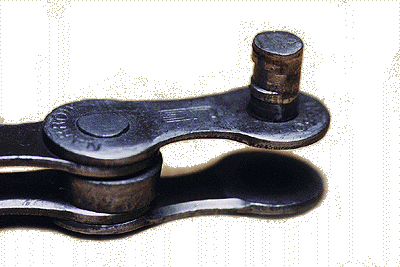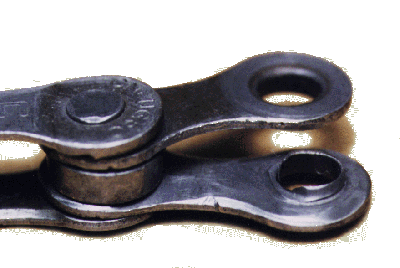Chain lubricant can be one of the most controversial aspects of bicycle mechanics. It seems like most mechanics you talk to will have their own opinion as to what's best and they will strongly defend their choice. So what is the difference between the chain lube and why are there so many kinds?
Before we begin, let's go over some facts about chain wear.
How does a chain wear and what is Chain 'Strech'?
As a bike is pedaled, the roller, pin, and bushing parts of a chain are forced together under a high load. This causes friction between the metal parts, causing them to wear down. The first picture below shows wear on the pin, the second picture shows wear on the bushing part of the inner link plate (hard to see, it's shown as the lower left part of the hole wearing away).
.

As these parts wear, the pins gradually become farther apart across inner link plates. This what is referred to as 'chain stretch' Chain stretch is a term that can easily be misinterpreted. The link plates do not actually stretch and get longer, rather, the chain is wearing down between the roller, bushings and the pins. .
How can I tell how worn my chain is?
The easiest way is with Park Tool CC-3.2 chain wear gauge or by bringing it to the shop for us to measure. It's possible to measure wear with a ruler also. For the sake of keeping this short, see sheldonbrown.com-chains for instructions on how to measure wear with a ruler.
What is the difference in the quality/price of chains?
The type of material used in chains can vary depending on quality and price. A higher priced, higher quality chain will use a harder metal that resists wear better. This harder material will also allow for hollow pins and open side plates that make chains lighter without sacrificing strength too much. Better quality chains use better manufacturing methods that leave off sharp edges and result in tighter tolerances between moving parts. This makes a chain stiffer resulting in more accurate shifting.
Why do you need to lubricate a chain?
Chains need to be lubricated because the inner workings of a chain operate on metal-to-metal contact while moving under a load. Whenever metal contacts metal in a moving part, lubrication is needed to prevent wear, corrosion.and noise.
What is the best chain lube?
If you ask five mechanics what lube is best, you're likely to get five different answers. For this reason, I'm going to stay away from 'this is the best' and focus on the differences between lubricants.
Generally speaking, a thicker chain lube will last longer. Lubricants such as Chain L, Phil Wood Tenacious, and Finish Line Wet are thicker lubes that last longer. The disadvantage to these is that they're messy and require regular chain cleaning. These lubes are good for people who want to go longer periods between lubing their chains but don't mind the added maintenance of cleaning a chain.
Lubricants such as Finish line dry lube are lighter weight and don't build up gunk or attract dirt, but they wear out quickly and there will be more chain noise as the bike is pedaled. Good for people who lubricate their chain often but don't like to clean it.
Finish Line Ceramic Lube and Rock-n-Roll Gold are designed to run cleaner by bonding with dirt inside a chain and moving it outside the inner workings of the chain. These lubes require that you wipe the chain off with a rag after one or two rides and reapply lube every 3-4 rides. The advantage is the chain will run smoother, last longer, and is much easier to clean . The disadvantage is that if the chain isn't wiped off, it will create a mess on the drivetrain. (these are the favorites of the techs at the store where I work)
Wax lubes such as White Lightning and Dumondetech are long lasting lubes that won't attract as much dirt. The disadvantage to these is that they build up a hard wax on the chain and sprockets that can be difficult to clean off, many times requiring a strong degreaser to remove.
The lubricant that is on brand new chains is the best lube for chains and should not be removed. The stock lube will last a couple hundred miles.
The lubricant that is on brand new chains is the best lube for chains and should not be removed. The stock lube will last a couple hundred miles.
Other lubes:
Silca NFS lubricant is a long lasting lubricant that allows the drivetrain to run smoothly and silently for 300-400 miles between applications. Each application takes only 12 drops on a chain. From my experience this lube works very well as they say it does and it lasts longer than most lubricants, without making a mess. The downside is the cost ($16/2oz). Although it's durabilty means a bottle will last just as long as a 4 oz bottle of wet lube, this is hard to convince customers. This is good for cyclists with high end bikes who want the best. silca.com
Tri Flow is a great Teflon based lubricant that works very well but tends to wear off quicker than most chain lubes and attract more dirt. Even considering these disadvantages, it's the favorite of many mechanics because it's light weight penetrates to the inner surfaces quicker. I use Tri Flow on cables and derailleur pivots where quicker penetration is important due to the small spaces and tight tolerances.
WD40 and 3-n-1 oil are far too lightweight and will wear off within a mile or so. However, the solvent in WD40 makes it a great, cheap way to clean parts (although messy)
Tri Flow is a great Teflon based lubricant that works very well but tends to wear off quicker than most chain lubes and attract more dirt. Even considering these disadvantages, it's the favorite of many mechanics because it's light weight penetrates to the inner surfaces quicker. I use Tri Flow on cables and derailleur pivots where quicker penetration is important due to the small spaces and tight tolerances.
WD40 and 3-n-1 oil are far too lightweight and will wear off within a mile or so. However, the solvent in WD40 makes it a great, cheap way to clean parts (although messy)
Motor oil contains detergents made specifically for the demands of engines. Even though they are thicker, they will wear off quickly and leave a mess behind.
Choosing a lubricant is like choosing a bike. Each lubricant has it's advantages and disadvantages. You should answer some questions to help find the correct one:
What conditions do you ride in (dry,dirt, mud, rain, etc)
How many miles do you ride?
Do you have time to clean your chain?
Finally, you should avoid spray-on (aerosol) lubricants if possible. Overspray is difficult to contain and will get lubricant on tires, rims, brake rotors, and the living room carpet.
I hope this helps answer some questions about chains and lubrication. For a great video on how to lubricate a chain, click here.
Should a chain be cleaned?
Gunked up and dirty chains that are not worn out should be cleaned. There are many different ways to do this. At the shop I work in, we remove chains to clean them in an ultrasonic cleaner. The chain is then dried with an air compressor to remove all of the solvent. This is the best way to get all the dirt and old oil out of the inner workings of a chain. This is also the most difficult and time consuming.


For most people, the easy way to clean a chain is with a Park chain cleaning system . It's easy, quick, and keeps the mess to a minimum.
It's also possible to spray the chain with an abundance of WD40 or another spray-on solvent, scrub it with a stiff brush, then wipe it off with a rag. The advantage to this method is that it's cheap. The downsides are big: it creates a huge mess, you stand the chance of getting dirt, oil, and solvent on your rims, tires, and brake rotors, and you won't be able to get all the solvent out of a chain. That leftover solvent will cause the new oil to break down right away.
For many riders, the easiest and best way is to use a 'clean' lubricant such as Finish Line Ceramic or Rock-n-Roll Gold. These lubricants can easily be wiped off with a rag and don't build up gunk when used properly.
I hope this helps shed some light on chain care and maintenance. Thanks for your time!
I hope this helps shed some light on chain care and maintenance. Thanks for your time!
Thanks to sheldonbrown.com/ information and pictures.
Comments
Post a Comment